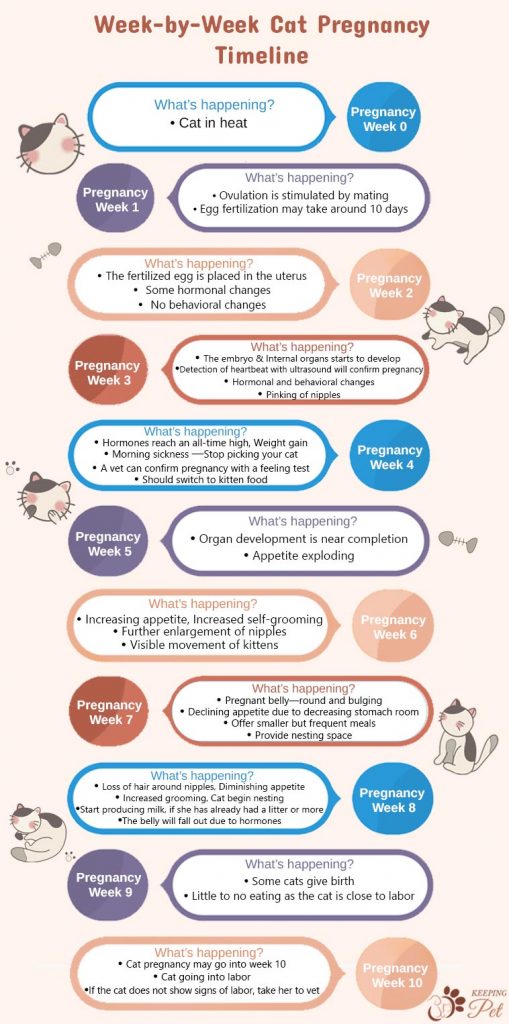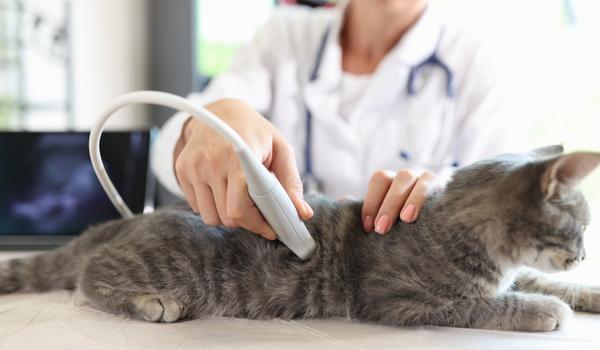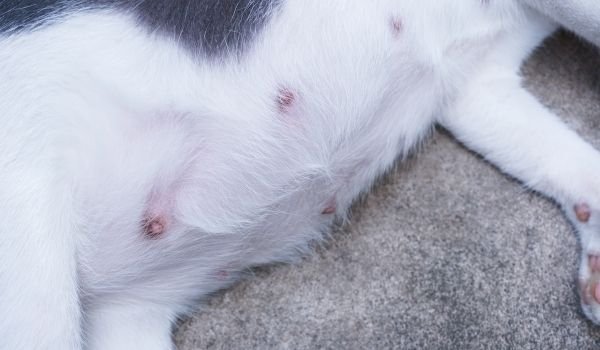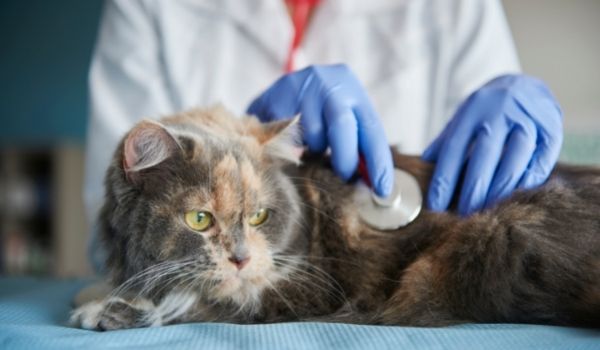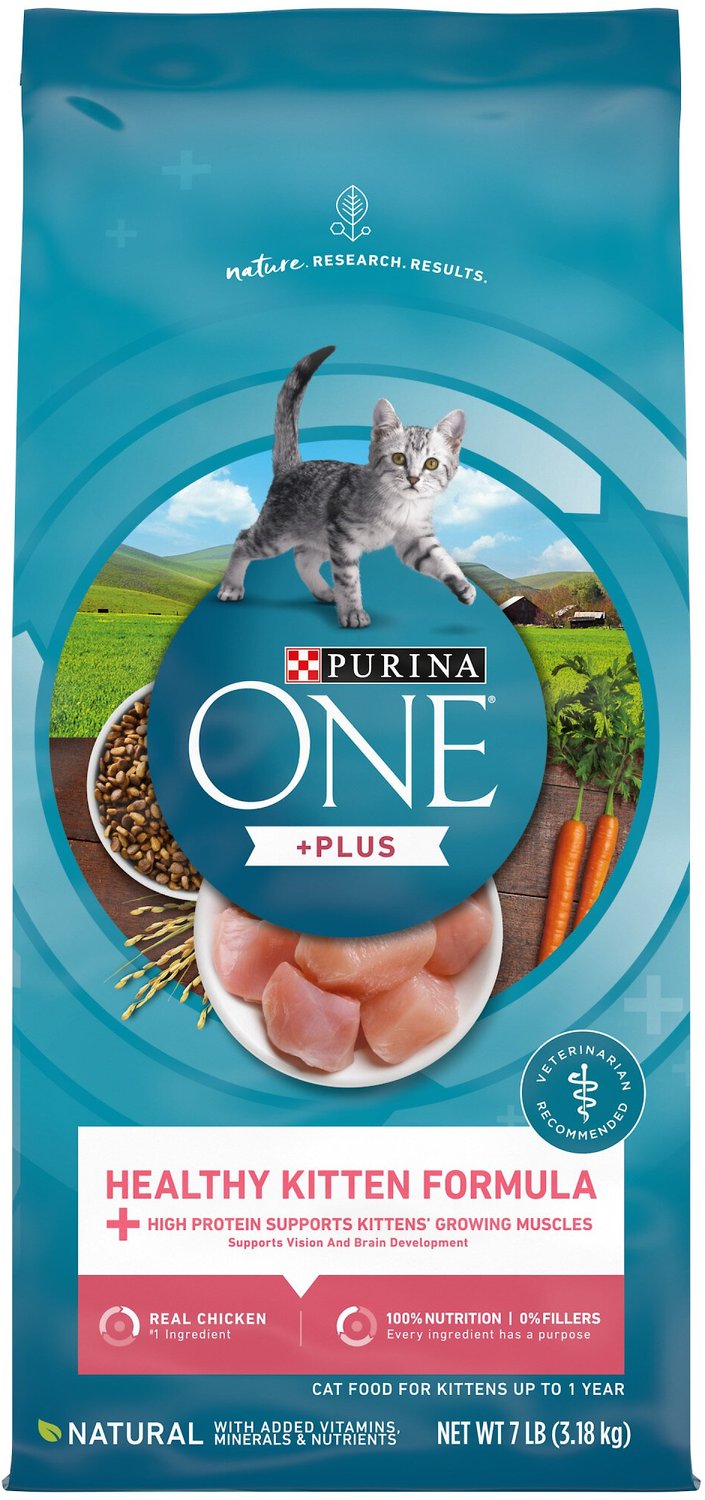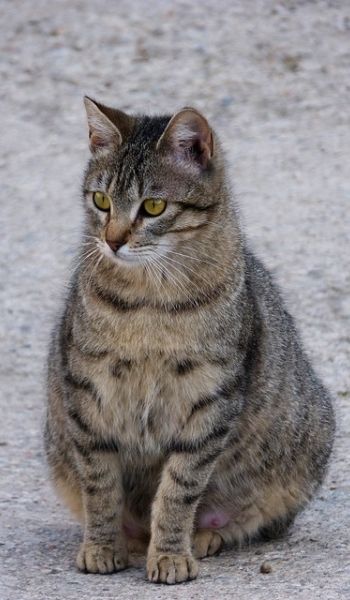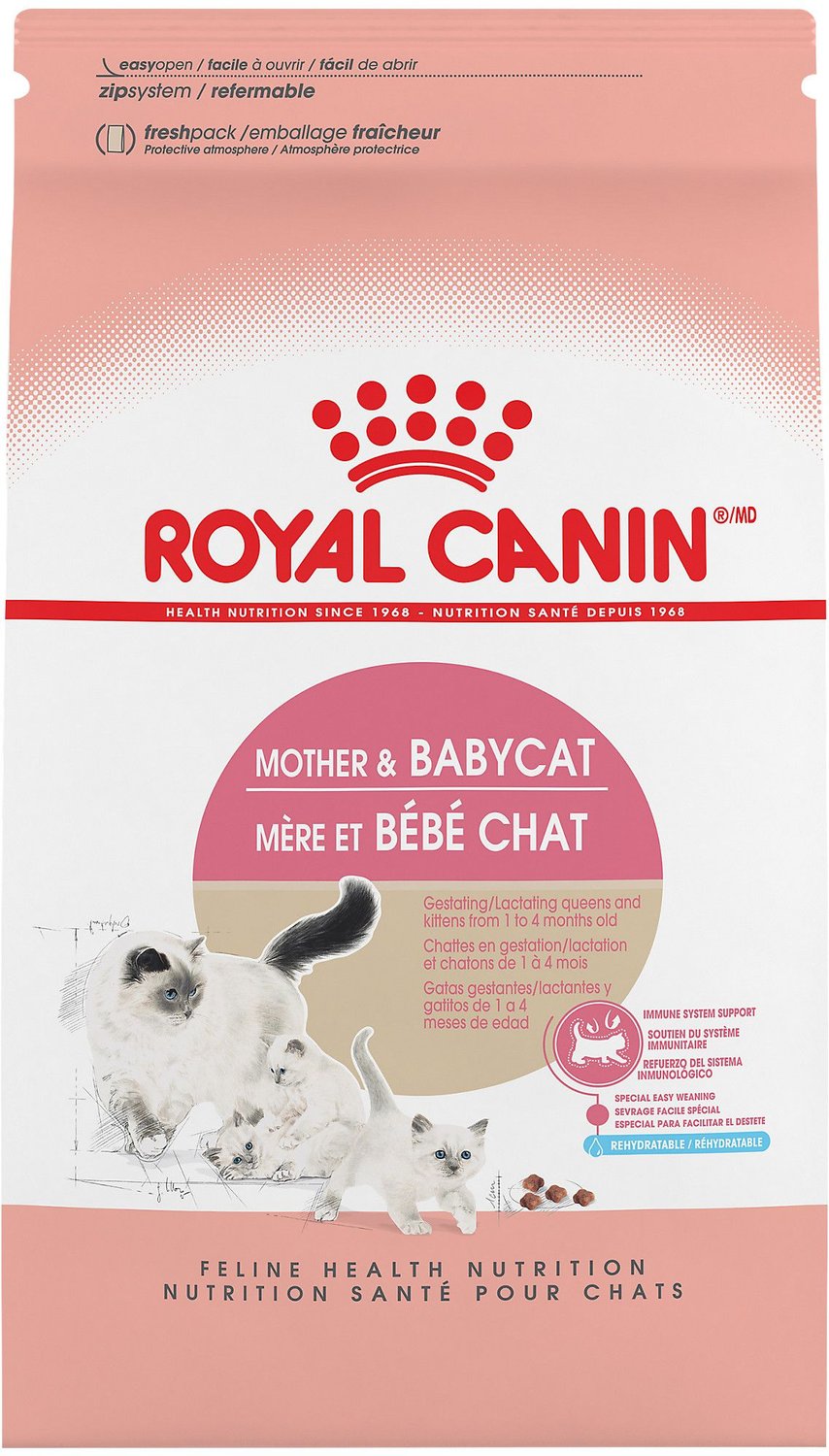Cats are seasonally polyestrous—they experience multiple cat heat cycles during the breeding season. The breeding season goes all year round for indoor cats and cats living in more tropical regions closer to the equator, where they have longer daylight hours. On the other hand, for cats living in the Northern Hemisphere, the breeding season is from late January or early February to the late fall.
Cats get pregnant pretty easily. Even kittens as young as four months could get pregnant. This means that you can have a 6-month-old kitten giving birth to a litter of kittens. This might be problematic—a 6-month-old kitten would not be able to take care of her kittens and would be highly susceptible to feline pregnancy issues. This is why cat owners are advised to wait until the cat has stopped growing and fully matured.
If you are not planning on breeding your cat, you should get her spayed before she turns four months so that you don’t have an unplanned pregnancy at your hands. Many unplanned pregnancies present cat parents with the hard decision of spaying the pregnant cat, which puts an end to the pregnancy.
That said, whether the pregnancy is planned or unplanned, you need to provide the best possible care to your cat during the cat pregnancy stages. That requires an understanding of how to tell if a cat is pregnant.
How to Tell if a Cat Is Pregnant?
The most common and earliest signs of cat pregnancy are the pinking and enlargement of cat nipples and the ceasing of the cat heat cycle (cats usually go into heat every 2 to 3 weeks). Besides that, a pregnant cat would become overly affectionate and exhibit morning sickness. As pregnancy progresses, there will be a significant increase in cat appetite and weight gain. You will also see the characteristic burrow-shaped pregnant belly.
If you think your cat is pregnant, you should take her to a veterinarian to confirm the pregnancy.
Now that you have confirmed your cat is pregnant and is in good health to support a healthy pregnancy take a quick look at the dos and don’ts of caring for a pregnant cat.
Caring For a Pregnant Cat
Dos
- Take your kitty for a wellness check as soon as you discover she is pregnant.
- Examine her for fleas, ticks, and worms, and put your cat on safe anti-flea and deworming medicines after consulting the vet.
- Put your cat on quality kitten food or food for pregnant cats.
- Gradually increase your cat’s caloric intake as she has to provide for the kittens growing inside her.
- If there is a complication in pregnancy or an accident, see a vet.
- Provide extra love to your kitten and remove all the potential stressors from her surroundings.
- In the final weeks, keep her indoors and offer comfy blankets, towels, and nesting boxes as the gestation period comes to a close.
Don’ts
- No vaccination during pregnancy. Ideally, cat vaccination should be up to date before mating.
- No deworming after two weeks of pregnancy.
- Don’t try to feel your pregnant cat’s belly—you could hurt babies or cause an abortion.
- Don’t lift your cat in the later stages of pregnancy.
Cat Pregnancy Stages
Mostly cat pregnancy lasts for around two months—60 to 67 days—averaging 63 to 65 days. That said, for some cats, the gestation period may extend beyond 67 days, and cats suffering from bacterial infections or other health issues may go into labor too early. Pregnant Queens undergo overwhelming developmental, hormonal, and behavioral changes during this pregnancy period.
To better understand what is happening at different cat pregnancy stages and how you can provide the best possible care to your pregnant cat, let’s break down cat pregnancy week by week.
Fertilization
To get pregnant, a cat has to be fertile—she must be on heat. On average, cats—unspayed female cats—go into heat every two to three weeks for around six days. During the cat heat cycle (also known as the estrus cycle), your Queen is ready to mate, and if kept indoors, she may try to escape in search of a Tom.
If you are not planning on breeding your cat, you should get her spayed before she reaches sexual maturity and becomes able to get pregnant. Usually, kittens can get pregnant at four months of age.
1 Week Pregnant Cat
The first week of cat gestation is conception. After mating, the sperm may take around ten days to fertilize the egg. After fertilization, eggs are moved to the uterus through the fallopian tube, which may take from 12 to 14 days.
2 Weeks Pregnant Cat
During the second week after the implantation of fertilized eggs in the uterus, the placenta starts to form. During this period, embryo development is also initiated, and the Queen also experiences some hormonal changes. However, your feline friend has no behavioral changes at this stage.
Cats are Induced Ovulators!
Cats only release eggs for fertilization when their ovaries are stimulated during mating. Usually, a Queen needs to mate around 3 to 4 times within 24 hours to ovulate. A Queen may give birth to kittens of different fathers!As a cat needs to mate multiple times to ovulate, she may end up having coitus with more than one Toms; thus, there could be kittens of different males in your cat’s litter.
Embryo Development
During this period of cat pregnancy, the embryo is developed, and organs start to develop in the embryo. Moreover, the placenta formation contributes to the exchange of waste and nutrients between the embryo and the Queen.
3 Week Pregnant Cat
During the third week of the cat gestation period, embryo development continues, and internal organs also start to develop. During this week, hormonal levels rise, and cat nipples start to enlarge and darken. This is the first visual sign that your cat is expecting.
4 Week Pregnant Cat
During the fourth week of cat pregnancy, hormones are soaring to an all-time high, and your cat starts to experience morning sickness. Four weeks into pregnancy, your cat may also experience vomiting. During this period, the pregnant cat’s weight continues to increase. If your cat’s weight is decreasing or the vomiting is frequent and seems uncontrollable, you should contact your vet.
You should also stop picking up your cat as this can hurt the soon-to-be kittens developing inside your cat’s belly and lead to miscarriage.
Fetus Development
By the end of the fourth week, the embryo has developed into a fetus. As fetuses are growing into kittens, your cat’s appetite will increase—she might be eating around 1.5 to 2 times her normal caloric intake.
5 Week Pregnant Cat
During this week, fetuses are growing rapidly into kittens—organ development is near completion, hormonal glands become functional, and nerves are developed. Your cat’s caloric intake would increase rapidly as it has also provided nutrition to the growing fetuses
6 Week Pregnant Cat
As kittens are growing big in size, requiring more nutrition, your Queen’s appetite will be exploding. You must switch to AAFCO-approved kitten food, which will meet the nutritional requirements of both the litter and the mother cat as well. It is best that you switch to kitten food as soon as cat pregnancy is diagnosed.
|
|
While a vet can do an x-ray of your cat by day 42 into pregnancy to confirm pregnancy and tell the number of kittens you should expect, it is advised that no x-ray is done before 55 days of the gestation period.
7-Week Pregnant Cat
By the 7th week, your cat will have a bulging and round belly. As kittens have grown, they are now pressing against cats’ internal organs, including the stomach, so there is little room for food in your cat’s stomach. This leads to an apparent decrease in her appetite.
Keep in mind that the mother cat still has to provide for the kitten growing inside of her and thus still needs more nutritional intake. However, due to decreasing capacity of her stomach, she is eating less. In this situation, you should provide smaller but more frequent meals to your cat.
8 Week Pregnant Cat
Kittens are fully developed, and you will be able to notice their movement in your cat’s belly. Her belly will further fall out at this stage of the cat’s gestation period. This is to make nursing kittens easier after birth. Due to hormonal changes, your cat will be grooming extensively and will also start losing hair around the nipples.
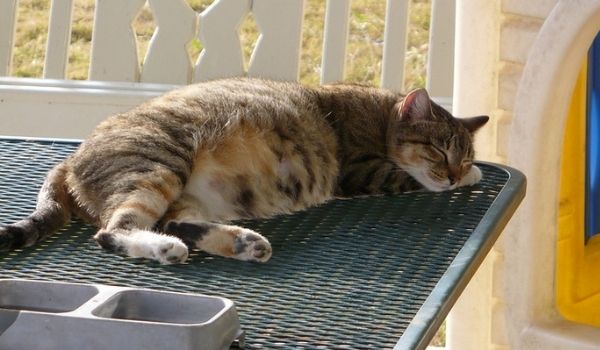
Pre-labor
As the gestation period comes to a close, your cat will enter the stage of pre-labor about a week before she gives birth to the litter. Due to the excessive grooming around the nippular area, the cat’s nipples would become very visible. If your cat has had a litter previously, she will start producing milk during week 8 of pregnancy. Otherwise, you will see milk dripping from her nipples in the 9th week.
If your cat has entered the pre-labor stage, she will start looking for a quiet, warm, and cozy place where she can deliver her kittens. You can help your cat by offering her comfy blankets and nesting boxes during this stage.
9 Week Pregnant Cat
As the average cat gestation period is 63 to 65 days, your cat may deliver during this week, especially if she has been showing signs of pre-labor in the past week. As labor in a cat is closing, your cat will be anxious and jumpy. She will have little to no appetite as kittens have greatly reduced the stomach room and as kittens are on their way. During this stage, your cat will start producing milk; if she has had a litter before, she may even drip a few drops.
10-Week Pregnant Cat
While most pregnant cats will have given birth by week 9, it is fine for cats to carry the litter into the 10th week. This may be related to the number of kittens in the litter or the cat breed.
However, if your cat has not gone into labor by the end of week 10 of pregnancy, you must contact your vet. Though chances are you might have miscalculated the dates, you should still ask your vet if something is wrong.
| Pregnancy Week | What’s happening |
| Week 0 | Cat in heat |
| Week 1 | Ovulation is stimulated by mating Egg fertilization may take around ten days |
| Week 2 | The fertilized egg is placed in the uterus Some hormonal changes No behavioral changes |
| Week 3 | The embryo starts to develop Pinking of nipples Hormonal and behavioral changes Internal organs start to develop Detection of a heartbeat with ultrasound will confirm the pregnancy |
| Week 4 | Hormones reach an all-time high Morning sickness Weight gain Stop picking your cat A vet can confirm pregnancy with a feeling test Should switch to kitten food |
| Week 5 | Organ development is near completion Appetite exploding |
| Week 6 | Increasing appetite Increased self-grooming Further enlargement of nipples Visible movement of kittens |
| Week 7 | Pregnant belly—round and bulging Declining appetite due to decreasing stomach room Offer smaller but frequent meals Provide nesting space |
| Week 8 | Loss of hair around nipples Increased grooming Cat begins nesting Diminishing appetite The belly will fall out due to hormones Start producing milk, if she has already had a litter or more |
| Week 9 | Some cats give birth Little to no eating as the cat is close to labor |
| Week 10 | Cat pregnancy may go into week 10 Cat going into labor If the cat does not show signs of labor, take her to vet |
|
|
If your Queen is nearing the end of her gestation period, you should make sure that you are prepared for the big day. And as your cat enters week 9 of pregnancy, you should start looking for signs of labor in the cat.
Labor And Delivery
As the gestation period comes to a close, your cat will start showing signs of impending labor. Most cats stop eating around 12 to 24 hours before giving birth. However, some cats may continue eating right up until they deliver. She will become overly affectionate. But as she enters the labor, she will be restless and anxious, pacing around, panting, purring, and becoming wary of strangers and other cats.
The excessive licking of the genitals and discomforting noises would make it obvious that the cat has entered labor and may deliver the first kitten of the litter in an hour or so. After the delivery of the first kitten, the cat will pass the ‘afterbirth,’ the dark-colored mass (placenta) in which the kitten was developing. The Queen may rest for about 10 minutes to an hour before delivering the next kitten.
Kittens are delivered within their amniotic sacs, with umbilical cords attached to their bellies. As soon as a kitten is delivered, mama cats tear up the amniotic sac and stimulate the kitten to breathe by licking them clean. She will also sever the umbilical cord by chewing on it. This severance point of the umbilical cord becomes the belly button.
If mama cat is exhausted and seems to be ignoring the kitten, and it is still in the sac, you will have to intervene. Carefully tear the sac and stimulate breathing by rubbing a soft dry towel in the kitten’s mouth and nose. You will also have to cut off the umbilical cord: tightly know dental floss around the cord about an inch from the kitten’s body and cut it using a sterile scissor from the mother side of the knot.
It might look gross, but the mama cat might consume the placenta to compensate for the energy expended in the exhaustive delivery.
If the Queen continues to push for over an hour, but no kitten is coming out, there might be some issue; you should immediately contact your veterinarian. If the cat has entered the resting stage of labor, there is nothing to worry about, and she will deliver the rest of the kittens after she is rested.
Kitten Are Out! What Can You Do?
Well, if the mother cat is doing her job, you need not intervene.
As soon as the kitten is born and the amniotic sac is cleared off, they will gravitate toward cat nipples, latch on and start to nurse. Mama cat will nurse the kittens for anywhere between 6 to 10 weeks. Where most kittens are weaned by the age of seven weeks, some may take up to 10 weeks.
You will have to continue feeding high-quality pregnant cat food or kitten food to the nursing cat. You should gradually start switching back to normal adult cat food when the cat is done nursing the kittens and all kittens are completely weaned.
When Do You Need to Intervene?
However, you will have to intervene if the mother cat abandons the litter or seems not to be taking care of her kittens. Mother cats not only nurse all of their kittens but also keep them clean and tidy.
So, if the mother cat is not nursing the kittens or is gone for long hours and does not come back to nurse the kittens regularly, you should consider intervening. If kittens are not well-groomed, know that the mama cat is not doing her duties well. If kittens do not seem to be gaining weight, they are not properly fed.
If the mother cat seems to be around all the time but is not letting the kittens come near her, check if the mama cat has swollen nipples—she might have mastitis. In this case, you should immediately get her to the veterinarian.
If your cat is trying to hurt or eat her own kittens, you should intervene immediately and separate the kittens from the mother. While it s not common for cats to eat their young ones but in certain circumstances, they might.
Check out: Why Do Cats Eat Their Own Babies?
You should also know that the journey does not end as the kittens have come into this world. But that’s when things get crazy—the rollercoaster ride begins. Caring for a mother cat and newborn kitten can be overwhelming. But taking quick looks at the kitten feeding chart and kitten growth chart and knowing things like kittens’ nursing period or when do kittens open their eyes can streamline the journey a bit.

